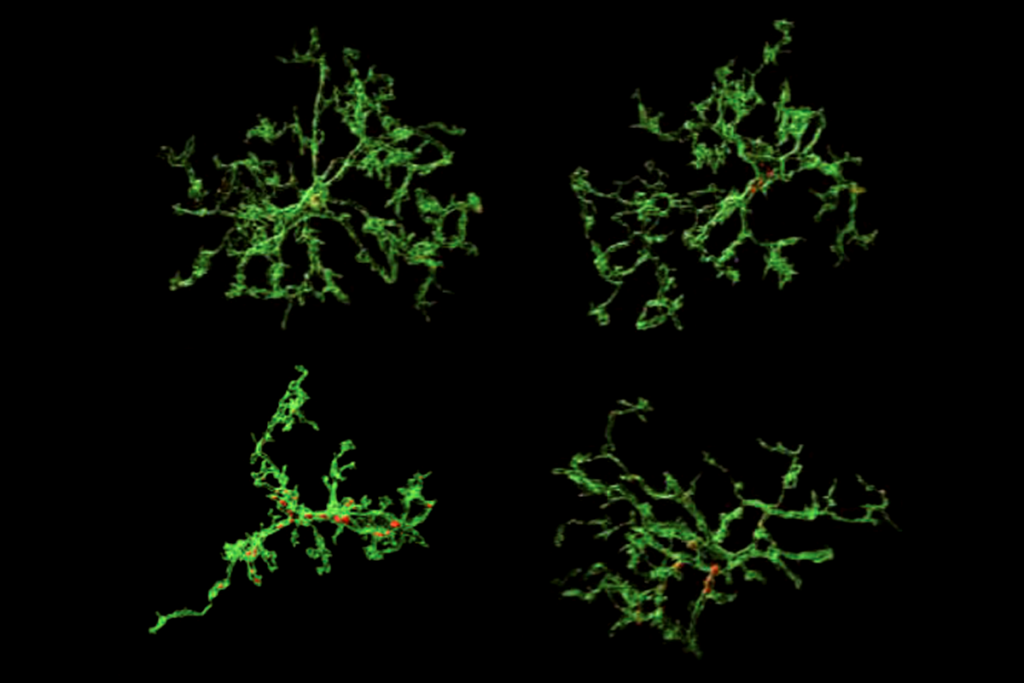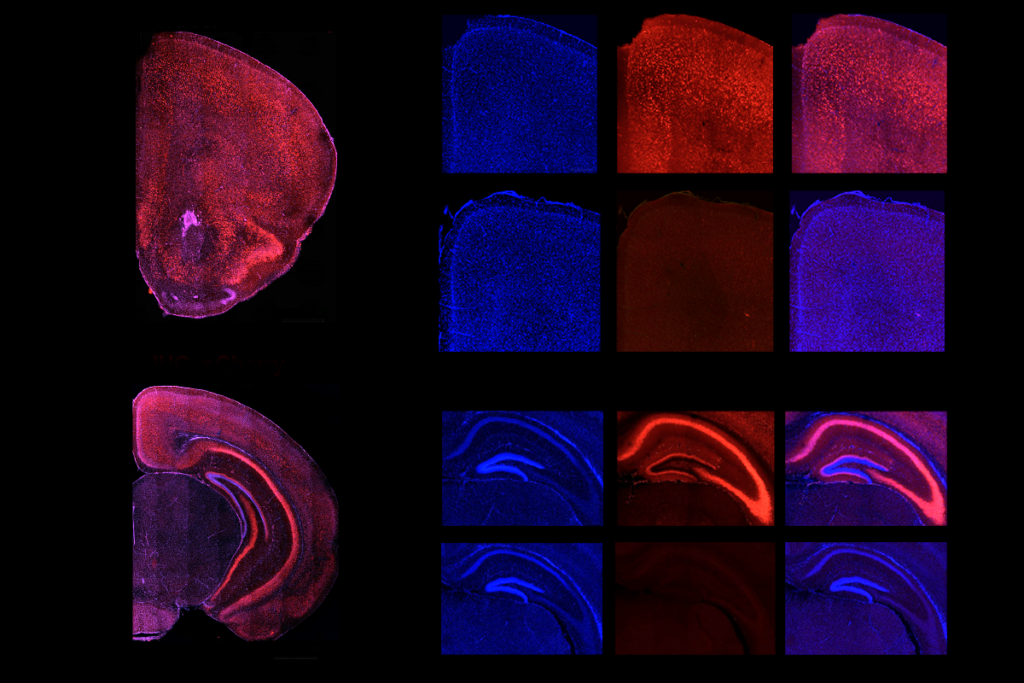Drug linked to mitochondria treats mouse model of autism
A century-old drug created to treat African sleeping sickness reverses several autism-like features in a mouse model of the disorder, according to a study published 13 March in PLoS ONE.
A century-old drug created to treat African sleeping sickness reverses several autism-related features in a mouse model of the disorder, according to a study published 13 March in PLoS ONE1.
The drug, called suramin, blocks purinergic receptors, which sit on the surface of every cell in the body. These receptors are indirectly controlled by mitochondria, organelles that provide each cell with energy.
Robert Naviaux and his colleagues at the University of California, San Diego, gave suramin to mice whose mothers had been exposed to a mock infection during pregnancy. Other studies have found that these mouse pups have social and communication deficits and repetitive behaviors reminiscent of autism. They also have motor problems and lose Purkinje cells — a type of cells found only in the cerebellum, a region involved in movement planning and sensory integration.
Suramin improves the animals’ social behaviors and motor coordination, and prevents the loss of Purkinje cells, the study found.
Several experts say the results are intriguing, if preliminary. “I think it’s a great paper because it shows how important mitochondria are to the brain,” says Douglas Wallace, director of the Center for Mitochondrial and Epigenomic Medicine at the Children’s Hospital of Philadelphia, who was not involved in the work.
It’s not yet clear whether the drug would work in other animal models of autism or in people with the disorder, he adds.
Naviaux declined to discuss the details of his study with SFARI.org, citing the deluge of emails he has received from parents of children with autism. “I am very concerned that our work is being oversold,” he wrote in an email.
In the 1980s, studies testing suramin on people with AIDS or cancer found that it can cause a range of serious side effects, including skin rashes, fever, headaches and vomiting2. Its long-term effects are unknown.
Naviaux plans to launch a placebo-controlled clinical trial to test a single dose of suramin, with effects lasting only a few weeks, on 20 boys with autism. If successful, the trial might lead to the development of safer drugs with a similar mechanism, he notes. “Only after that will I know if we are really on to something or not.”
Danger signals:
No one knows how many children with autism have mitochondrial problems. An invasive muscle biopsy can identify severe mitochondrial defects, but more subtle problems are difficult to measure. Still, many studies since 1998 have linked autism and mitochondria3.
For example, some individuals with the disorder have mutations in genes relating to mitochondrial function and others carry blood cells that produce less energy than control cells do. Scientists have also found abnormal mitochondria in postmortem tissue from the cerebellum, frontal cortex and temporal cortex of young children with autism.
The new study is one of the first to probe the biological mechanisms underlying these mysterious links, experts say.
“This paper dramatically supports the hypothesis that mitochondrial dysfunction is the root cause of autism,” Wallace says. He believes most cases of autism stem from problems with the mitochondria, though this has not yet been proven. “The brain occupies only 2 percent of the body’s weight but uses 20 percent of [its] oxygen. It’s by a factor of ten more sensitive to subtle mitochondrial defects than any other organ in the body,” Wallace says.
Mitochondria are known as the cell’s power plants because they help convert food into a molecular energy source called adenosine triphosphate, or ATP. When a cell is damaged, however, ATP and other chemicals made by mitochondria — collectively dubbed mitokines — can act as a molecular ‘danger signal.’ They bind to the purinergic receptors of nearby cells, spurring them to ramp up defense mechanisms against pathogens or chemical stressors, for example.
By blocking the purinergic receptors with suramin, the new study tests the theory that some cases of autism result from dysfunctional mitochondria that produce chronic danger signals, causing too much activity at the receptors.
Purinergic signaling is involved in many biological processes linked to autism, such as the development of synapses, or junctions between neurons, as well as gut permeability, immune responses, brain inflammation, and the activation of microglia, the brain’s immune cells.
“The cell danger response theory explains so much that was inexplicable before,” Naviaux wrote in a prepared email response to patient inquiries about the study.
His team tested the theory on mice born following a mock infection of pregnant mice. The offspring show a striking loss of more than 60 percent of Purkinje cells, the researchers found. Synapses in the rest of the brain are fragile and malformed and have 50 percent fewer purinergic receptors than controls do. This latter effect may be a compensatory response to chronically overactive signaling, according to the study.
Naviaux’s team also found that the mice have several metabolic abnormalities. For example, their body temperature is half a degree Celsius cooler than normal and their brains show hyperactive mitochondria-related enzymes.
An injection of suramin at 6 weeks old, which is after the animals reach sexual maturity, restores social behavior, motor coordination and metabolism. Suramin also partially normalizes the structure of their synapses and prevents further death of Purkinje cells.
As with all mouse studies, it’s impossible to know whether the drug would have the same effect in people with autism, Wallace says. If it does prove effective, he adds, it is likely to work only in the subset of people with autism who have this particular defect in the purinergic pathway.
It’s encouraging that the treatment works on mature mice, after the onset of symptoms, notes Paul Patterson, professor of biological sciences at the California Institute of Technology, who developed the maternal infection mouse model. “That’s really a very exciting part of this — that you can do it later,” he says.
Still, the data suggest that the drug would need to be taken for life. “Is it safe to turn down your metabolic profile?” Patterson asks. “It’s such a broad-acting drug in that sense. It’s not a silver bullet.”
Correction: A previous version of this story reported that the drug does not improve communication deficits or repetitive behaviors. In fact, these mice do not show repetitive behaviors, and the study did not measure ultrasonic vocalizations, according to lead researcher Robert Naviaux.
References:
1. Naviaux R.K. et al. PLoS ONE 8, e57380 (2013) PubMed
2. Voogd T.E. et al. Pharmacol. Rev. 45, 177-203 (1993) PubMed
3. Giulivi C. et al. JAMA 304, 2389-2396 (2010) PubMed
Recommended reading

Constellation of studies charts brain development, offers ‘dramatic revision’

Functional connectivity links with autism, not ADHD; and more

Ramping up cortical activity in early life sparks autism-like behaviors in mice
Explore more from The Transmitter

‘How to Change a Memory: One Neuroscientist’s Quest to Alter the Past,’ an excerpt
